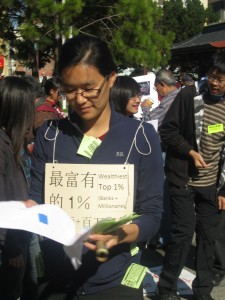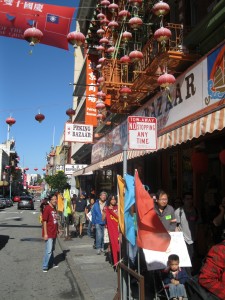Amid children running around, men playing majong, and the general hubbub of Sunday at Portsmouth Square, in the heart of San Francisco's Chinatown, the Chinese Progressive Association (CPA)] staged a skit and speaker's program intended to explain why the Chinese-American community should view themselves as part of the 99 percent cited by the Occupy Wall Street movement.
In attendance were Supervisors John Avalos and Eric Mar, both of whom said they were there because their districts are strongly linked to Chinatown -- Avalos and Mar represent many Chinese-Americans in their districts in the Excelsior and the Richmond. Many of these constituents started in Chinatown and moved out to those neighborhoods once they had saved enough money.

Emily Lee, an organizer with the Chinese Progressive Association, played the character of "One Percent" in the skit.
"I think a lot of people understand and they personally identify with this story of the 99 percent because," she said. "As with most immigrants, you come here to America, you’re chasing the American Dream, you want more opportunity, they came for their kids, for better education. And that’s a universal story in the Chinese community."
Lee said that in general the Occupy San Francisco movement is not portrayed favorably in the Chinese-language media. The focus there has been more about the sanitation and public safety concerns and many in the Chinese-American community have written the movement off as a bunch of "white hippies." Lee says that she's been down to the OccupySF encampment and those stereotypes aren't true. She hopes the Chinatown event will help people realize that their immigrant stories are part of the economic injustice central to the Occupy movement.
